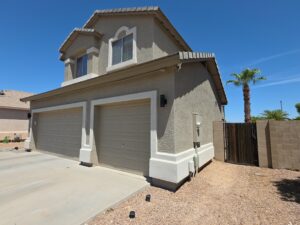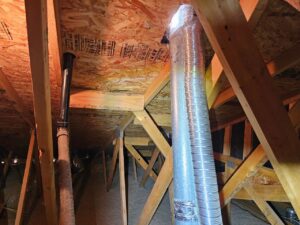Home Inspection: Inside a 1981 Mesa Home
Mesa Crawlspace Walkthrough: What a Rainy Day Reveals Beneath a 1981 Home
Hey, it’s Home Inspector Dan. Today I’m under and around a 1981 Mesa home, and last night’s rain couldn’t have timed itself better. Damp conditions make it easier to trace where water travels and where it likes to sit, both key clues when evaluating older homes with crawlspaces.
Crawlspace & Site Conditions
At the main shutoff, water pressure clocked in at a healthy 65 psi. The crawl opening, though, needs attention: weak vent cover, poor grading, and a slope that encourages runoff toward the access instead of away. That’s an open invitation for both moisture and pests.
Inside the crawl, several supply ducts are resting directly on the soil – never ideal. Aside from wear-and-tear concerns, that setup puts the ducts within easy reach of rodents or insects that can chew through the material. I found some wet soil and light rusting under the bathroom area, suggesting prior or ongoing leaks. Ventilation around the perimeter is minimal, so airflow is limited, another factor that can trap humidity beneath the home.
Exterior Overview
Outside, the property presents well. The vinyl siding looks tidy and secure, with no visible warping or loose panels. The driveway shows normal settlement cracking for its age. A mesquite tree out front adds charm but will need regular trimming to keep branches clear of the structure and roofline.
There are termite bait stations around the property, though the ants seem to appreciate them most at the moment. Roof inspection showed patchy staining above the room where the interior ceiling is sagging, always worth correlating exterior roof wear with what’s happening inside.
The 40-gallon Rheem water heater, located in an exterior closet, appears relatively new and properly piped with a TPR discharge to the exterior. The electrical panel is a Bryant with colored breakers – models known for reliability issues that merit evaluation by a licensed electrician for long-term safety.
Interior Findings
Stepping inside, the laundry is right by the entry, convenient layout, but there’s no ceiling exhaust. Without mechanical ventilation, expect higher humidity unless windows stay open during dryer use.
The kitchen remodel is clean and functional overall, though there’s no water line to the refrigerator and some stripped screws at the dishwasher mount. I noted mild ceiling discoloration from prior moisture exposure, now dry.
Doors and windows open smoothly, but the front door sags slightly and the strike plate hardware is either loose or missing. These are easy, low-cost adjustments that improve both security and efficiency.
Bathrooms show typical aging signs: one sluggish drain stop, drawers that rub the wall, no mechanical exhaust fans (casement windows only), and standard caulking gaps at tub edges. On a smaller home like this, a single smoke alarm technically meets minimums, but adding one more in the bedroom area would provide a safer margin.
HVAC System
This Mesa home has a 2007 Day & Night 4-ton R22 condenser paired with a Coleman air handler. Cooling performance was adequate, but rust was visible at the coil and drain pan, and the air handler lacked a proper restraint in its closet. This setup should be serviced, cleaned, and securely mounted. Thermal imaging and ceiling inspection confirmed prior moisture near the “droopy” ceiling area noted from the roof stains outside.
Sewer & Septic
For this property, the Scout 3-Pro Plus Purple AHD sewer camera came along for the ride. The ABS drain line showed grease buildup and debris, and I couldn’t advance far due to a tee-style cleanout restriction. The home is on septic, with the tank roughly 20 feet out back.
In Arizona, a Title 19 septic transfer inspection is required before any sale. The seller is responsible for having the tank inspected and pumped; the buyer typically handles the line inspection from house to tank. For this system, I recommend a hydro-jet cleaning to remove buildup before final verification.
What Does This Mean?
Even with some wear, this Mesa home is holding up decently for its age. Most findings fall into maintenance and safety upgrades rather than structural alarm bells. The key is managing moisture, from crawlspace drainage to ceiling leaks, to keep the foundation, ducts, and framing dry.


 Hi, I’m Home Inspector Dan — owner of Property Inspections Plus and a
Hi, I’m Home Inspector Dan — owner of Property Inspections Plus and a 




